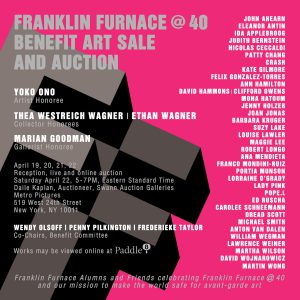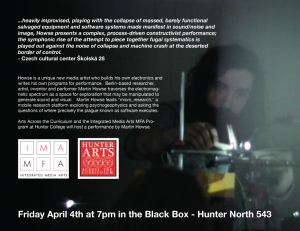Archive for the ‘performance art’ Category
Zach Blas Contra-Internet at Art in General
Contra-Internet: Jubilee 2033 trailer from Zach Blas on Vimeo.
I had been looking forward to seeing Zach Blas’s Contra-Internet exhibition at Art in General, unfortunately it was not as engaging as I had hoped. The exhibition presents one single channel video installation that features the nearly 30 minute film “Jubilee 2033” and three other single-channel video works on monitors. The three video works on monitors present ideas and research regarding the internet – the hegemonic network of today and for the foreseeable future – through computer screen recordings by Blas. (I really hope that artists stop using screen-recordings of themselves clicking through files as a medium; it’s seldom interesting.)
Although I was disappointed by the exhibition, the gravity dance performance by Cassils as Nootropix, “a contra-sexual, contra internet prophet” is captivating an entirely worth the trip. The premise of the film is funny as it opens with Ayn Rand discussing the future of her ideas with two of her followers – Alan Greenspan and a fictional character Joan Mitchell. A young Greenspan proposes that the group take an acid trip. I was turned off by the highly accented performance of Rand and her cult, so I was glad to see them drop liquid acid.
As the trip begins, an internet connected artificial intelligence in the form of a manga character appears and takes them in to the future. The future is of course dystopian as the present reality burns and it’s certainly fun seeing the Google headquarters burning along with other tech companies in the not so distant future of 2033.
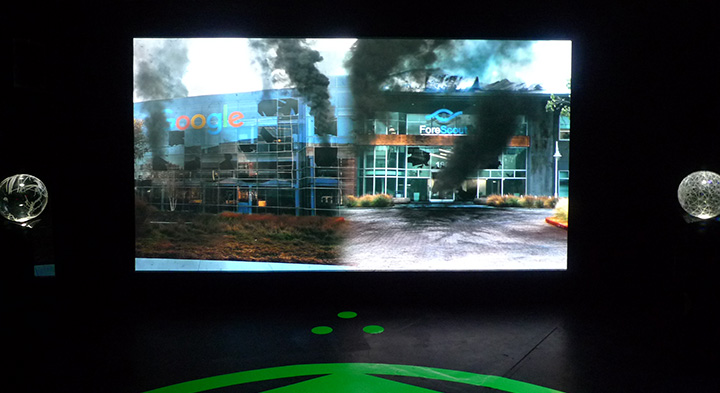
Along their travels, we encounter tech workers being taken hostage by “The Art Professor” wearing gray, paint-splattered coveralls and wielding a machine gun. Later in a classroom, the Art Professor introduces Nootropix (Cassils) who in their monologue states that they will perform the creation of gravity. The performance artist is powerful and their dance upon a purple matrix while dawning a large, erect, glowing CGI penis that is constantly spewing black liquid is awesome. The dance is mesmerizing and triumphant.
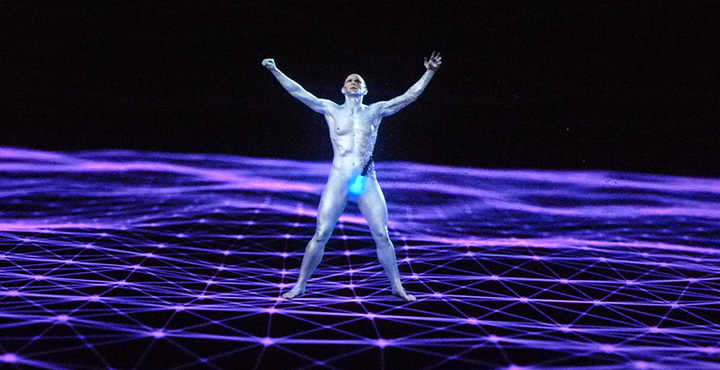
In Nootropix, Blas presents one of his contra-internet exotic creatures “to discover or create a world of network difference.” I could have entirely skipped the storyline, and merely be fantastically transported by Cassils’s character and performance as I think that it would have left me asking more questions and appreciating the mystery. We know that a network of difference is not plausible, so why not create the fantastic and shed the tedious philosophizing.
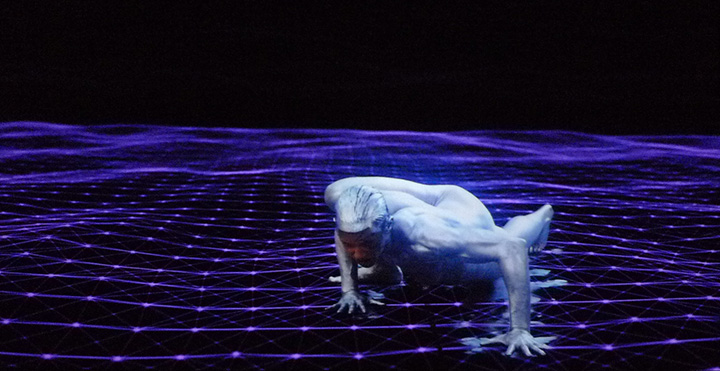
Reflections on “Arlington”
Imagine a sterile white waiting room with a row of three plastic blue chairs to the far left and a tall narrow window to the far right. At the back, to the right is a wide fish-less aquarium, to the right of the aquarium on the wall a paper cup dispenser and nearly at the right corner the only door to enter or leave the waiting room. It is a narrow and tall door. On the drop ceiling are four surveillance cameras and mounted on to the wall behind the plastic chairs a microphone on a gooseneck. On the other side of that left wall, is a control room with a desk and many small monitors all about the room.
In Enda Walsh’s “Arlington” the waiting room is at once an isolation room and an observation room but more importantly a psychological prison. I went to the play (currently at St. Ann’s Warehouse) because I was interested in seeing how the piece melded multimedia with the actors on the stage as I had read it was quite successful; I was not disappointed.
The play that combines theater, dance, video, music and lighting effects to create a work of speculative fiction that delves in to existential reality based in contemporary, first-world society. Initially the play brought to mind Calderón de la Barca’s “La vida es sueño” (Life Is a Dream) (1635) – “Man dreams what he is until he awakens…” I read the play over 20 years ago and what I recall is that a prince, Segismundo is imprisoned in a windowless tower since his childhood. He is given a tutor to have a formal education. When he dreams he recalls his life before imprisonment – playing feely as a child. He confuses his dreams with his reality – to him his dreams that recall freedom are his reality and the time spent in the tower alone or with his tutor is sleep time. The play popularly considered a masterpiece of the Golden Age of Spanish Theater brings to the forefront questions of free will versus fate and whether life is a dream or a reality. Similarly, Isla, the main character in “Arlington” is imprisoned and has one individual to communicate with – the 32 year old technician that sits on the other side of the wall and observes her. As with Segismundo, it is unclear how long Isla has been in this waiting room and like Segismundo the waiting room is at the top of a tower.
At one point there are allusions to her having supernatural powers as she is the one constructing the towers that rise outside, beyond the window. As the piece progressed, it brought to mind Netflix’s “The OA” – an 8 episode series that also presents imprisonment, torture, the question of reality versus psychological construction. And as the combination of video projection and light effects were woven into the play, I couldn’t help but also think about Netflix’s “Black Mirror”.
There is a middle section in the play, following the freedom of Isla, when a new woman is inserted into the waiting room. This section is gripping due to her movement. The character has no words, but her dance choreographed by Oona Doherty speaks clearly of anger and resistance.
The final character to be inserted in to the waiting room is the 32-year old technician who apparently freed Isla from the room. As with Isla, he recalls elements of his childhood that appear to have left psychological scars.
There is one sequence of the play in which immense faces are projected onto the far wall, one after the next – a portrait of the audience and the accompanying narration is a philosophical reflection on the society that we have constructed. I need to find the entire play, in particular this narration.
I attended “Arlington” with my friend Erica and she shared her thoughts with me:
I walked into Saint Ann’s warehouse blind. I had no idea what kind of performance Ricardo had invited me to, but I was excited and my feeling was that it would be a simple yet creative production. Just moments after finding our seats, perfectly situated a few rows up towards the middle, the dimly illuminated theatre went black. The curtains opened up to the sides and the stage lights lit up revealing a very basic set depicting a waiting room. Nothing out of the ordinary. All the items were typical of what you would expect to find – a coat rack, three plastic chairs, a waiting ticket number dispenser, a fake plant and an aquarium. However, everyone’s attention was on her- a plainly dressed young woman who was waiting for her turn in what seemed to be a doctor’s office. Something felt odd though. She was staring out of the one window in the room. She seemed confused or lost in a thought. It didn’t take long to grasp that this was not your standard waiting room scenario. For one, there was a mike on the wall like the one used by the fast food drive thru operator. And second, there were four cameras in each corner of the room monitoring the girl. Third, and the weirdest, there was a nervous nerdy guy in a small room next door full of monitors watching and talking to her as if he were her watch guard.
She was obviously not mentally stable and in need of attention. He was definitely a geek who was lonely. Both establish an awkward relationship without ever seeing one another. There are many extensive monologues. It was difficult to ascertain whether the world she was describing is the real environment in which the story is set, or if she is nuts and has concocted a world where everyone is living in waiting rooms like hers and jumping out of windows when they can’t stand it any longer. Am I like her? If so, to what degree? I couldn’t help but think about my own sanity. Within 30 minutes or so, she has stolen his heart and he finally opens the door to let her out of the waiting room. She presumably is freed.
The next scene was the most difficult to sit through. I was literally so uncomfortable that at one point I had to look over at Ricardo and establish eye contact with him in order to feel that this was just a performance and I was not part of that world. Once he looked back at me, this was enough to confirm that we still belong to our crazy world that we’ve normalized and not the unfamiliar, insane world on the stage. The woman before our eyes was clearly in pain. For what seemed like forever, she was banging her chest, slapping her thighs, hitting the floor, throwing her shoes, running and twirling about the waiting room in such a chaos. There was a series of images and music throughout that at times made me feel disoriented. This woman didn’t say a word and she didn’t need to. The choreography was great. The emotions it stirred inside of me, disturbing. I felt she was going to be one of the falling leaves the previous girl had described in one of her monologues. At the end, sure enough, this leaf fell- right out of the window.
The last scene begins with the pathetic watch guard nerdy guy being thrown into the waiting room. He was bloody, and it’s unclear what the hell he’s done. From above, like an omnipresent god, a woman invoked his childhood traumas, and interrogated him not letting him sleep until he confessed what he saw. Apparently when he opened the door to let the woman out, he followed her into a forest where either he killed her or found her dead. How is this known? By a huge projection of her walking in a forest that was shown behind the wall of the waiting room. By the end of his psychological torture, the woman appears to him and reassures him that once “this is over” they will be reunited. They embrace briefly, he falls asleep, and she disappears.
FRANKLIN FURNACE @ 40
Help the Franklin Furnace continue to make the world safe for Avant-Garde Art (the really weird shit that the NEA is afraid of). The Furnace has turned 40 and is now relocated in Pratt Institute, however, in order to re-grant money to artists that challenge the norms of our society, the Furnace needs financial help. Anyone can donate to the Furnace anytime, but at this time the Furnace is holding a benefit art sale and you can participate via Paddle8!
Exhibition, Friday-Saturday April 19-22, 10am-6pm
Reception and Live Auction of Five Works, Saturday April 22, 5-7pm
Metro Pictures, 519 West 24 th Street, New York, NY 10011
FRANKLIN FURNACE @ 40 Honorees
Yoko Ono, Artist
Thea Westreich Wagner & Ethan Wagner, Collectors
Marian Goodman, Gallerist
FRANKLIN FURNACE @ 40 offers for sale original art by:
John Ahearn, Eleanor Antin, Ida Applebroog, Judith Bernstein, Patty Chang, Nicolas Ceccaldi, CRASH, Kate Gilmore, Felix Gonzalez-Torres, Ann Hamilton, David Hammons/Clifford Owens, Mona Hatoum, Jenny Holzer, Joan Jonas, Barbara Kruger, Suzy Lake, Louise Lawler, Maggie Lee, Robert Longo, Ana Mendieta, Franco Mondini-Ruiz, Portia Munson, Lorraine O’Grady, Lady Pink, Pope.L, Ed Ruscha, Carolee Schneemann, Dread Scott, Michael Smith, Anton van Dalen, William Wegman, Lawrence Weiner, Martha Wilson, David Wojnarowicz, Martin Wong.
“Broken Bone Bathtub” Review

Broken Bone Bathtub by Siobhan OLoughlin
This past Saturday night a bit before 9pm, I stepped down into a basement apartment in Long Island City, Queens, just a couple blocks from MoMA PS 9. A few weeks ago, I read glowing reviews about Siobhan O’Loughlin’s immersive theater piece Broken Bone Bathtub that occurs in private bathrooms, so I decided to check it out. Once through a small door that I had to duck under, a coat rack outside the apartment entrance received the audience. I went with a friend and we entered behind a young couple who were very excited about the experience. We stepped in to the living room of the apartment and were greeted by a cheery hostess who invited us to chocolate fondue and nuts and a few other appetizers. Red wine was also available, but required a small donation. The hostess, told us about herself, the apartment – voluntarily lent by immersive theater fans and the actress as we waited for the Siobhan to gather herself; this was the second performance of the evening.
A few minutes later, another young woman nodded to the hostess indicating that the actress was ready for us. The hostess asked for two volunteers who would be comfortable speaking and contributing to the piece. Two young women raised their hands and were taken to the bathroom for introductions and instructions. A few minutes later, the remaining four of us, were invited to enter the small bathroom; the audience was a total of six.
Siobhan sat naked in a cast iron bathtub, her breasts concealed by soap bubbles. The two volunteers sat adjacent to the bathtub and the rest of us took seats on a toilet, stool, small chair and small plastic step stool. The actress thanked us for coming asked if we were all comfortable and then began her narrative. Her left arm was in a cast, decorated with signatures and drawings. She told us about the pain and the time necessary to recover from a broken bone and the difficulties of day to day life with her left arm in a cast. She began to detail how the accident happened, riding her bike to an activist meeting along the west side of Prospect Park, headed to Grand Army Plaza. She asked if we were familiar with the area, everybody appeared to be and as I ride it regularly, she asked me to describe it. Following my description of the area, she told us that it was a rainy night and there was a husband and wife riding south as she rode north. It was dark and wet and perhaps the couple had been riding in tandem. She collided with the woman. The husband immediately attended to her wife as Siobhan found herself alone and in a great deal of pain…
Through the performance, topics such as who do we call at a moment of emergency, loneliness, whether or not we cry, were discussed by both the actress and the audience. She seamlessly moved through the responses from audience members back to her narrative. At one point she sang a song as one of the volunteers either scrubbed her back or conditioned her hair. She joked that throughout this period of healing, she borrowed the bathrooms of friends in order to not be alone. And throughout the performance she made sure to include each audience member.
The piece was smart and thought provoking. Unfortunately, the bathroom door was left ajar and at the beginning, the residents of the apartment were taking cell phone photos of us in their bathroom. Later, at times it was distracting to look out to the living room and see people on their devices. However, in general, the manner that Siobhan was able to weave the audiences’s discussion in to her performance was impressive. The one weak element in the piece was unfortunately the conclusion.
Siobhan entered a seemingly heartfelt conclusion, she allowed herself to cry as she discussed moving on from the healing period. The crying and the final monologue felt contrived in comparison to the rest of the performance, because unlike the preceding narrative, it did not engage dialogue, but was instead prescriptive. The uniqueness presented by the back and forth between the actress and each audience was broken and the piece reverted to conventional theater – a one way presentation. It would have been transformative, if each conclusion appeared to vary given the audience interaction. Siobhan could still maintain the underlying message, but it would be great if she was able to draw from what was shared by a given audience to inform the concluding monologue rather than loose the sense of immersion.
The Voice Who
On a February Friday afternoon walking along Fulton near Nostrand in Brooklyn, my son and I encountered an artist/writer/performer/thinker mounting painted wooden statements or declarations to the temporary plywood of a construction site. We paused to ask him about his declarations and he broke them down one by one. According to the artist each sign represents a book that he is working on, but they also sound like moments and reflections from his life.
On View at Cuchifritos Gallery
Artist Antonia Pérez creates sculptures by weaving discarded plastic bags. She worked at the gallery during the exhibition.
This is the final weekend for the exhibition “Lettuce, Artichokes, Red Beets, Mangoes, Broccoli, Honey and Nutmeg: The Essex Street Market as Collaborator” at Cuchifritos Gallery located in the Essex Street Market. The exhibition curated by Nicolás Dumit Estévez Raful has been in the works for the past two years. The premise of the exhibition is for “six socially conscious artists to engage vendors, customers and the Market itself in their artistic processes as a means of co-generating experiences centered on the life that unfolds outside Cuchifritos Gallery, the art space of the Artist Alliance Inc”.
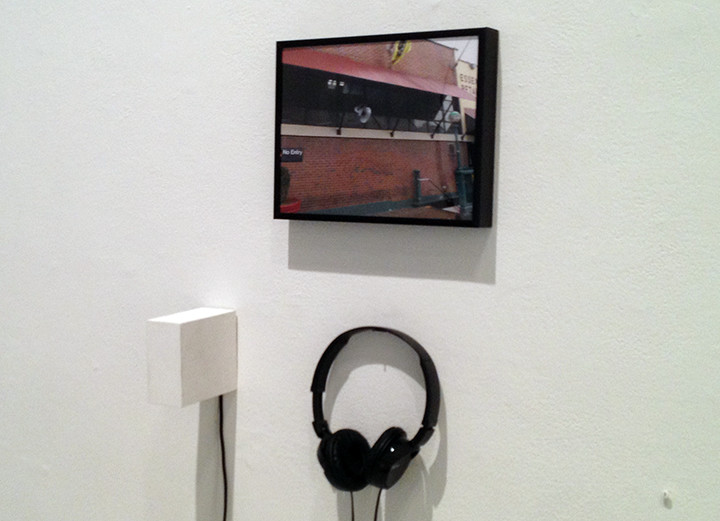
“Recetas y Gangas: The Essex Street Market Recordings” with mock up of originally proposed installation of bullhorn on the facade of the market
So in preparation for the exhibition, the artists came together with Jodi Waynberg the Executive Director of Artist Alliance as well as Nicolas to begin considering how the artists might work with the market. Jodi toured the artists through the market and introduced them to various vendors as well as the building manager and staff. Nearly all the artists attended a Vendors Association Meeting to present their projects and solicit collaboration.
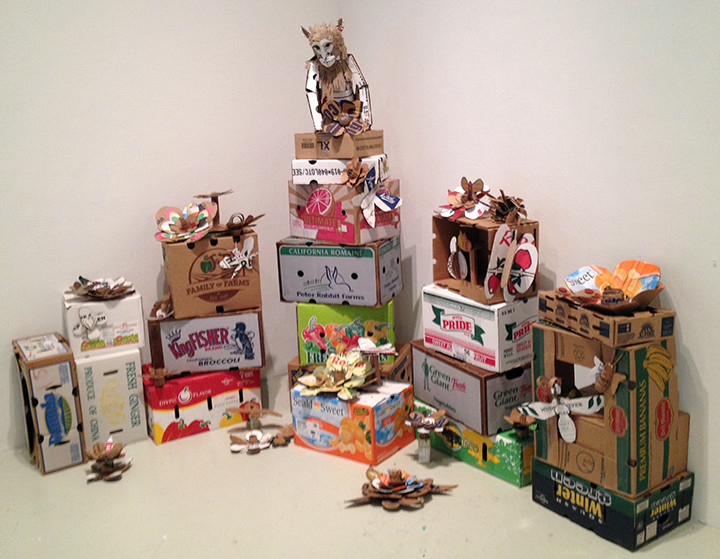
“Refuse Redo” a collaboration between Mary Ting and Lower East Side Girls Club/La Tiendita – sculptures made from market cardboard.
As one may imagine, the vendors are small business owners and workers. The market is the place that they go to for employment, not necessarily for cultural engagement. Many of the vendors are entirely preoccupied with maintaining their business and were no nonsense about artistic participation. If the artists did not approach with a brief and concrete plan for collaboration, there was little chance of any cooperation. A few vendors were excited at the prospect of creative engagement and happily collaborated. However in general, the ambitious projects envisioned by the artists needed to be simplified.
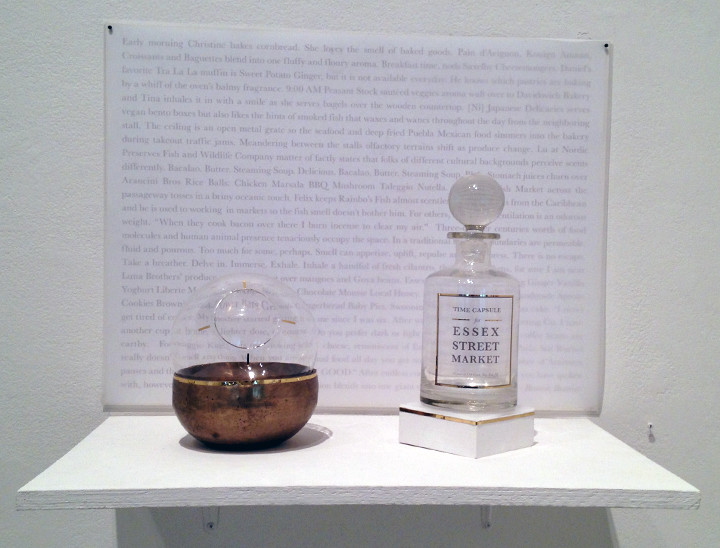
Scent and air time capsule of the Essex Street Market by Beatrice Glow.
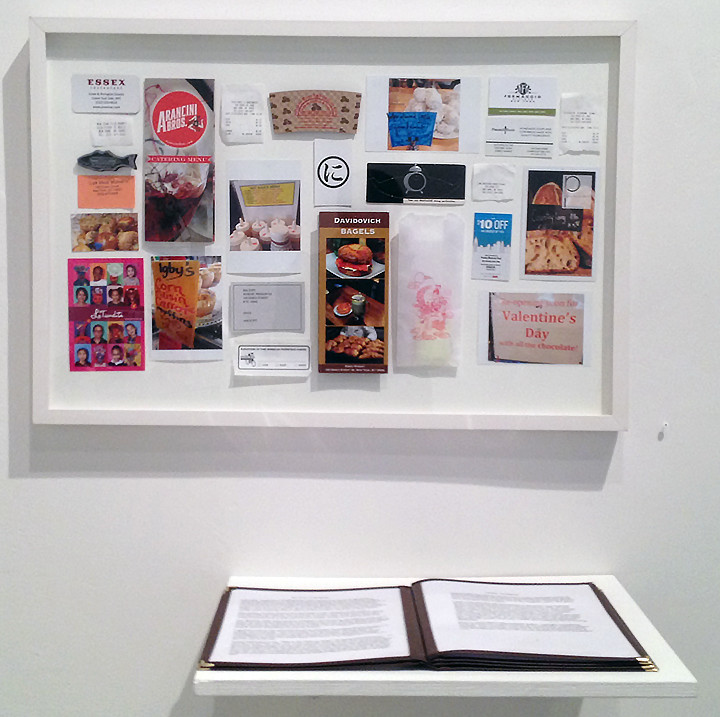
Market collection and journal by Inspector Collector Harley Spiller.
Laia Solé and Nicolás Dumit Estévez Raful employ the color green from the market to create a video montage that collapses the artists at work and the market at work.
For example, I wanted to create an audio montage of the vendors chanting or singing their goods and then to have that audio amplified onto the street via a bullhorn installed on the facade of the Essex Street Market. The concept was to have the interior of the market spill out onto the street as street markets commonly do in Latin America and Europe. Most of the vendors were not comfortable in singing their goods and the building management did not allow the installation of the bullhorn due to city ordinances regarding noise pollution (at least that was their excuse). When I was recording one of the vendors, a shopper approached me to tell me about recipes that she uses for a particular root. It then occurred to me that if vendors did not want to sing, perhaps they would share a recipe and the audio montage became primarily recordings of market recipes. As the piece would not be projected onto the street via a loudspeaker, I created a sandwich board with a speaker installed into it and wore the sandwich board on the street. In this way, the original concept of the piece was fully realized.
Each artist has her or his own story of how the work needed to be modified for the final exhibition. And in the end, this is the nature of collaboration.
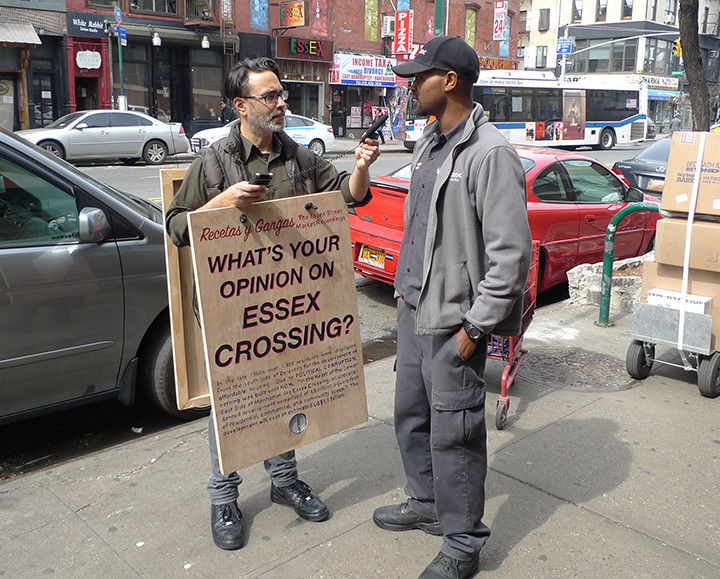
“Recetas y Gangas: The Essex Street Market Recordings” with mock up of originally proposed installation of bullhorn on the facade of the market
“Drifting in Daylight” at Harlem Meer
After getting lost in beautifully tucked away trails toward the north west corner of Central Park, the discovery of the S.S. Hangover made for successful end of art hunting in Central Park this past Saturday. The only one disappointed in our group of six art viewers was the 5 year old who had envisioned riding the boat along the lake as the music played. Fortunately the soft pleasant music performed from the boat by the brass sextet calmed our disillusioned interactive art connoisseur.
Upon studying the ship, my 6 year old immediately asked why there was a fat unicorn on the sail. A Creative Time attendant, corrected him that it was not a unicorn, but the winged horse, Pegasus from the myth of Hercules. To everyone’s disappointment, she went on to explain that the fat Pegasus represents the struggling artist who has gotten older and is unable to achieve artistic recognition and glory. I immediately wondered why the artist had to take a nice performative piece and stamp it with such a trite concept.
The boat appeared to circle around a small island as it performed a piece by Kjartan Sveinsson. We only remained for iterations that were relaxing and pleasant. As we continued to walk around the Harlem Meer, we encountered Karyn Olivier’s “Here and Now/Glacier, Shard, Rock” – a lenticular signboard that shifts between photographs of the immediate environment behind the billboard, a glacier and pottery shard that resembled a Western classical pottery work.
Upon exiting Harlem Meer and Central Park on the east side, we encountered Spencer Finch’s “Sunset (Central Park)” – a soft-serve ice cream truck that employs solar panels to cool and power the soft-swerve. The line for the free ice-cream was far too long for us to experience the solar-cooled ice cream.
Overall the work that we encountered was poetic and relaxing at a time when so much of the immediate social issues carry friction, stress and the growing schism between the rich and poor on our earth.
Victoria Estok & Steve Lambert Show that Cops Believe in Climate Justice

Victoria Estok with NYPD for Climate Justice

Steve Lambert Posing with Police for Climate Justice
Mart Howse Performing at Hunter College, April 4th, 7pm
Arts Across the Curriculum and the Integrated Media Arts MFA Program at Hunter College will host a performance by Martin Howse on Friday April 4th at 7pm in the Black Box – Hunter North 543.
Martin Howse is a unique new media artist who builds his own electronics and writes his own programs for performance. Berlin-based researcher, artist, inventor and performer Martin Howse traverses the electromagnetic spectrum as a space for exploration that may be manipulated to generate sound and visual. Martin Howse leads “micro_research,” a mobile research platform exploring psychogeophysics and asking the questions of where precisely the plague known as software executes.
Recently the Czech cultural center Školská 28 described Martin Howse performance as
“heavily improvised, playing with the collapse of massed, barely functional salvaged equipment and software systems made manifest in sound/noise and image, Howse presents a complex, process-driven constructivist performance; the symphonic rise of the attempt to piece together fugal systematics is played out against the noise of collapse and machine crash at the deserted border of control.”
Larry Bogad: Tactical Performance
Artist, performer, activist, professor Larry Bogad recently posted his TEDxUCDavis talk on YouTube. It’s well worth checking out and may inspire some fun and thoughtful hijinks!
